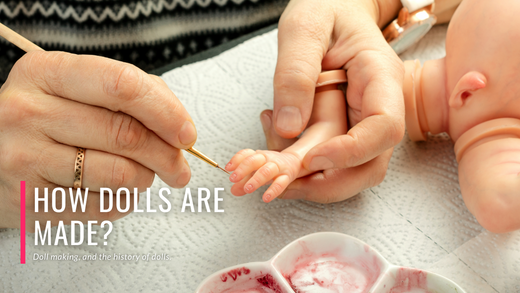How dolls are made?
With love of course. But, for a more detailed explanation, we will have to delve into their background, earliest attempts at their creation, variety of materials, and methods of creation used historically. Little basic course on the history of dolls.
While these days, dolls are ingrained into our culture as toys, something for young children to entertain themselves with, things weren’t always as simple. While many rudimentary dolls were built for entertainment, a good number of them had, and still have cultural, or religious meanings. Because even ancient deites enjoy toys, and there is nothing shameful about that.
The story of one of the first known dolls starts in Egypt, around 2000 B.C.
The Theban king Nebhepetre Mentuhotep II has just reunited the Lower and Upper Egypt, and established Thebes as the capital of the new Egypt. Egyptian society is going through sizeable changes, one of which is the flourishing of arts in all forms, including those of religious nature.
That is where we stumble upon our first type of doll, paddle doll. Not to imply this is the first doll in the existence of humanity, simply one of the earliest one’s historians are aware of.

Paddle Doll: Made from a flat piece of wood, and formed into a very basic shape, that depicts a woman’s torso, neck, and arms, with strings of beads that are meant to imitate hair.
There is little known about the true purpose of paddle dolls. However, many educated guesses have been made. One of which has to do with its unique shape and the beads attached to the back of the doll’s neck. To be more specific, the dolls bare a resemblance to menat amulets, Egyptian symbols of divine protection. The beads on menat amulets, when shaken, were meant to make a sound that appeased gods. It is believed that paddle dolls served a similar purpose, and were employed as musical instruments by troops of singers and dancers during religious ceremonies..
Many of the paddle dolls, as well as the menat amulets were found in the now ancient Egyptian tombs, further implying their status as religious implements.
As far as their creation goes, the process was fairly simple. A wooden board was carved into the pictured paddle-like shape forming the body of the doll. The hair was made from linen threads attached to the back of the doll’s neck, each thread then would be strung with beads. Finally, the body itself was decorated. Either carved further, or simply painted with textile patterns, accessories such as jewellery, or tattoos, to further bring the imitation to life.
People of Egypt were not the first and not the last to use dolls in religious rites, the tradition of using human effigies for such events has followed humanity throughout its existence, whether it was an ancient Egyptian ceremony, a voodoo curse devised by a shaman (or disgruntled teenage girl), or perhaps Slavic rituals to the goddess of winter, death, and rebirth, Marzanna.

Marzanna (Also known as Morana, Marena): Doll / Effigy depicting a Slavic goddess. The doll was drowned in a yearly ritual to symbolize the end of the winter, the dead period, and the following rebirth of the nature.
The life of Marzanna doll is not a long one. This is why perhaps while a lot of care is put into decorating one, not much is put into the material choice. Made from the straw core, wrapped in linens and then decorated with ribbons, beads and flowers. Marzanna could not be simpler to make. Which, considering its purpose is more than reasonable. A so-called tradition of the drowning of Marzanna starts in fact with burning of the doll, the flames would be then extinguished by the following “drowning”. Finally, the remains of the doll would be taken back to the village, proving that the deed is done and celebrating the start of spring.
In many Slavic countries, the tradition of drowning Marzanna is still practiced to this day. Perhaps we have them, to thank for the end of cold winters, or the global warming.
Speaking of global warming, let us jump forward to 19th century Germany and its industrialization.

By gailf548 - originally posted to Flickr as German Doll, CC BY 2.0,
Bisque dolls are at the height of popularity. German attention to detail, along with tools and manufacturing methods brought by the industrialization lead to not only a truly amazing creation, but a boom on the doll market. Called bisque, due to the so called biscuit porcelain from which they were made, these dolls reached new realm of beauty and life-like look to them. Sadly, we are lied to, and these as the name would imply, cannot be dipped in tea. Well, they can. I wouldn't, however, recommend eating them.
Majority of the now mass-produced dolls are made for the children entertainment, however, many are made directly for the collector market, with some unique pieces reaching prices, in hundreds of thousands.
How were they made? The process itself wasn’t very difficult, however, it did vary from one manufacturer to another. While their name might imply otherwise, it was only the head that was shaped from porcelain. Ceramic raw materials were pushed into a mould, which then was fired at temperatures of at least 1,260 °C (2,300 °F). Once shaped, and cooled down, the head would be painted. Multiple layers were applied onto the already realistic matte-like finish of the biscuit porcelain, further giving the faces life. After each layer of paint the heads would be fired again, as to seal the look permanently. The rest of the body was made from many different materials, is it clay, composition, or cloth. In many cases designed with moving joints.
It was also around the 19th century that the design of many dolls has forever changed. While, up to this point in history dolls were often made to imitate in shape adult women, not unlike the well-known barbie. Now, the dolls also take child-like appearance. From physique to more delicate features, along with accessories and dresses that might be more appealing to young Victorian ladies, which at the time were obsessed with German and French creations.
How are the dolls made today? The manufacturing process itself hasn’t changed much since the creation of bisque dolls. Moulds, and heat are still involved. However, the big change came with the material. Another advancement in doll making, which yet again, in a way, we have Germans to thank for.
With the end of World War II, many of the materials formerly developed for the use in warfare, now have been adopted by civilian manufacturers. One of which was of course plastic. It was in later 1940’s that we have seen the adaptation of the first hard plastic dolls. Much easier to manufacture than their counterparts, more durable, and most importantly much cheaper. Plastics quickly overtook bisque, composition and even china, as the most popular doll manufacturing material. Not only were plastics efficient, but also allowed never seen before number of details. At least in a mass-produced item.
Following the hard plastic, came the creation of vinyl in 1950’s. Variant plastic known for its flexibility.

BiBi Doll: Manufactured from vinyl by The Magic Toy Shop Ltd.
Today, vinyl is the material of choice for manufacturing of dolls all over the world. Possessing the same qualities of hard plastics, with addition of its natural softness, and further improved endurance. The new techniques, and the flexibility of plastics allow us to mass-produce dolls with features that in the past were only accessible to the more privileged families.
Animated eyes, along with moveable joints. Even speaking, or eating dolls. All made possible with modern technology. (And love, don't forget love.)
Here we have it, very brief history of dolls. I hope that now, if you ever wonder "How Dolls Are Made" you will have this article to help you.






